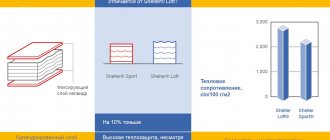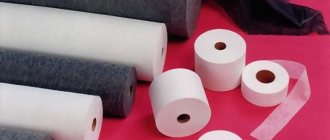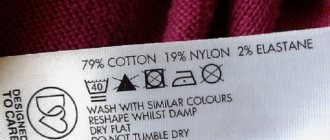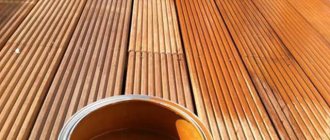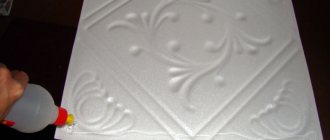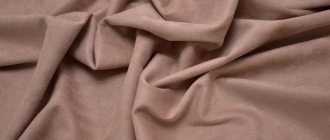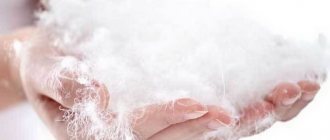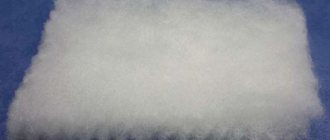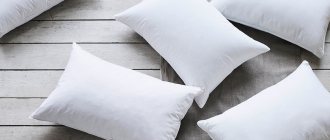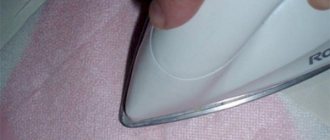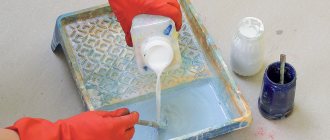Sintepooh is a filler made of polyester fibers, one of the varieties of padding polyester. The name of the material is derived from the phrase “synthetic down”. This emphasizes the similarity of the new type of filler with the natural down of waterfowl.
Composition and types of filler
Synthetic fluff in its characteristics is close to the properties of natural fluff, but is obtained artificially. This is what gave it its name - synthetic down, synthetic down. The material consists of polyester fibers with cavities protected from moisture. To achieve elasticity and airiness, the fibers are impregnated with silicone and twisted into a spiral, forming a single web. This process gives the material elasticity and also improves its thermal performance - the air cushion reliably stores heat.
The main advantage of this fabric is the absence of glue in the composition: it is used in the production of padding polyester and can cause allergies. Thanks to the latest production technology with the addition of silicone, the synthetic fluff filler does not bunch up, which avoids deformation of the product. The manufacturing process includes only one operation - the treatment of polyester fibers with silicone.
There are two types of insulation:
- spiral (this option is more elastic and practically does not wrinkle due to mechanical influences, quickly restores its original shape);
- ball (very popular as a filler for soft toys).
This is interesting: Thinsulate or fluff: comparative characteristics. All the pros and cons of insulation
Thinsulate
It is a synthetic insulation material that, despite its small volumes, provides good insulation properties. In other words, even with a thin thinsulate jacket you will not be cold in winter. Initially, this type of insulation was developed for the clothing of astronauts and polar explorers, but has now become firmly established in everyday life and is widely used when sewing outerwear for autumn and winter.
Advantages
Benefits of Thinsulate:
- ease
- retains its shape when washed
- the material “breathes” and provides good ventilation of clothing
- does not deform even after several years of wear
- does not cause allergies
- dries quickly, moisture resistant
- combination of relatively thin volume of material and good warming properties
Among the disadvantages of the material, it is worth noting that it accumulates static electricity (as do most artificial materials). Another disadvantage may be the price, which will be higher than that of products with other synthetic insulation. But on the other hand, a winter down jacket with such insulation will look more elegant (due to its small volume), while warming well and not requiring careful care. Here the choice will depend only on your preferences and priorities.
Temperature
According to its characteristics, Thinsulate is 1.5 times warmer than natural down. Depending on the density of the insulation, it can be designed for temperatures from 0 C to minus 30 C. Some types of outerwear with Thinsulate can protect against frost down to minus 60 degrees.
Thinsulate density is designated by the letters C, B TiB, P (ascending) - that is, the smallest density is C, the average is designated as B and TiB, and the highest is P. Thinsulate density is also indicated in grams per square meter:
- 100 g/sq.m
- 150 g/sq.m
- 200 g/sq.m
- 250 g/sq.m
- 300 gsm
Accordingly, the higher the number, the denser the insulation.
Care
One of the advantages of Thinsulate is that it does not bunch up when washed, keeps its shape and is quite easy to care for. Practically does not deform after washing - shrinkage after 5 washes is only 0.2%. It can be washed in a washing machine on a delicate cycle and water temperature from 30 to 60 degrees. It is best to squeeze the product by hand.
What and how is synthetic fluff made from?
Synthetic down is a filling made from synthetic polyester fibers. This is a non-woven material that is created from the smallest polyester fibers having hollow spaces in the structure. Thanks to the presence of these cavities, the insulation becomes incredibly light.
To make the villi more elastic, they are treated with a special silicone emulsion. After applying the composition, these particles are twisted into a spiral. Silicone treatment makes the material waterproof, so clothing dries quickly when in contact with moisture.
Sometimes synthetic down comes in the form of balls. This filling option for down jackets is shown in the photo; it is more resistant to pilling, so the products are practically not subject to deformation.
This material's properties can be compared to bird's down and feathers. Insulation is classified according to its linear density. This characteristic consists of the thickness and length of the pile. The degree of thickness is designated as 7 D or 15 D, the length can be 32 or 64 mm.
Each variety has its own advantages and disadvantages. Filling with a high level of elasticity retains its shape better, but is too rigid, so it is difficult for them to fill narrow parts of products. Thin pile is soft; to the touch this material is most similar to natural down, but it is less durable.
Manufacturing and equipment
Depending on the raw material, synthetic fluff can be made from primary and secondary polymer .
The technologies for forming the fiber and producing the synthetic fluff itself are the same for both types of polymer.
For recycled polyester, pre-treatment operations are still required. The idea of processing PET bottles into synthetic fiber and then into synthetic fluff is very interesting from an economic point of view.
Let's take a closer look at how ordinary plastic containers turn into modern insulation.
Types of raw materials
There are several ways you can go here:
- Purchase waste PET containers , grind, wash and granulate them yourself. This is a labor-intensive and lengthy process, which has its own subtleties.
- Purchase ready-made clean flex flakes as raw materials . The most optimal option in terms of price and quality, since during the recycling process the polyester was not melted, which means it was not subject to thermal decomposition.
- Purchase granulated recycled PET . Such raw materials are ideal for further extrusion due to their bulk characteristics. But, alas, its composition and processing conditions are unknown. There is a risk of purchasing low-quality plastic.
Obtaining polyester thread
To form and draw threads from molten polyethylene terephthalate, you need:
- Extruder . This machine not only melts the polymer, but also thoroughly mixes and homogenizes it. The simplest and most inexpensive option is a single-screw machine. To work with flex flakes, it is better to choose a device with a large diameter in order to fill the auger as much as possible. Since recycled PET melts easily, the extruder length can be around 30-35D. The main condition is the presence of degassing, at least natural. Ideally, you need a vacuum pump. Removing volatile components will eliminate odor in the finished thread.
- Melt filter . Located at the exit of the extruder. When working with recycled materials, it traps dirt and foreign impurities.
- Melt pump . Installed in front of the die. Its main function is to pump the melt towards the head and maintain a constant flow as it exits the head. When working with flex, it is extremely necessary, since the filter allows you to reduce pulsation and make the finished threads more uniform.
- Filera . Usually there are about 200-300 round cross-sections with many holes. For textile thread, their diameter is 0.2-0.4 mm.
- Winding station . To be wound into bobbins, the threads enter through a chamber where they are cooled by air currents. Winding takes place on a system consisting of several rollers. An interesting idea is to apply a lubricant (organopolysiloxane) to the threads before winding by spraying. Surface treatment with silicone at this very moment will protect the thread from gluing and make the surface of the fiber insensitive to moisture from the air. The reels will be stored better.
More information about granulation equipment can be found here.
Synthetic fluff production
- To produce synthetic fluff, the threads must be formed into bales . To do this, the coils are threaded into the stand of the unwinding device, which then feeds them into the chamber. There the fibers are mixed and treated with silicone. The output is a tangled web, which is cut into pieces if necessary.
- The main piece of equipment is the carding machine. Many hollow needles, moving in different directions, comb the fabric. The needles, capturing the threads, destroy and finish them in different directions. Many air voids are formed . And the fiber, acquiring the character of a spring, becomes elastic and resistant to load.
- Package . Synthetic fluff is usually packaged in bags or briquettes . The vacuum packaging system helps to significantly save space during transportation.
Average price per kg
To understand the economic attractiveness of producing this product, you can consider the approximate prices in the country for 1 kg of synthetic fluff made from recycled PET (minimum batch).
| City | Price per 1 kg/rub |
| Moscow | 165 |
| Saint Petersburg | 180 |
| Krasnodar | 140 |
| Volgograd | 129 |
| Ekaterinburg | 180 |
| Tomsk | 140 |
| Novosibirsk | 120 |
| Vladivostok | 200 |
Pros and cons of the material
Synthetic fluff has a number of advantages, which are determined by the properties of polyester fiber and the structure of the material:
- Breathability - clothes with padding made of synthetic fluff allow air to pass through perfectly, allowing the body to breathe freely.
- Water resistance - treatment of fibers with silicone increases the water-repellent properties of the insulation. The material does not get wet for a long time and dries quickly. Even when wet it retains heat.
- Environmentally friendly - synthetic fluff is not dangerous to human health, since no glue or other harmful mixtures are used in production. Environmentally friendly material is recommended for the manufacture of children's products.
- Hypoallergenic - synthetic down does not cause allergy attacks, since dust mites do not live in polyester fiber and fungus does not develop.
- Resistance to deformation - the springy structure of polyester fibers allows the product to retain its original shape for a long time. After compression, the filler instantly expands.
- Easy to care for - clothes with synthetic fluff insulation are easy to care for. It can be machine washed, hand washed, and dry cleaned.
According to customer reviews, clothes with synthetic down are wear-resistant and durable. The filler has only one drawback - with frequent washing, the insulation partially loses its thermal insulation qualities.
This is interesting: What is mohair: its features, composition, differences from angora
Sintepooh
Synthetic down insulation is a voluminous material whose properties are as close as possible to natural down. But it also has a number of advantages that are superior to natural material.
Advantages
Advantages of synthetic fluff:
- does not cause allergies
- light and yet warm
- Microorganisms do not live in synthetic material
- breathability, that is, the ventilation of clothing, the material “breathes”
- retains its shape when washed
- even if synthetic down gets wet, it will not lose its heat-saving properties
The disadvantage of synthetic down is that it is susceptible to deformation at high temperatures - therefore it should be kept away from heating devices and not ironed.
Synthetic fluff insulation is light and voluminous. It retains heat well and is very practical to wear. Pay attention to the density of the product, because such insulation can be used both in an autumn down jacket or jacket, and in winter outerwear. It makes especially good down jackets that are now fashionable with a straight silhouette, “cocoon” or oversize shape - they combine lightness, a comfortable fit, a stylish appearance and a modern filler with good warming properties. At the same time, the price of synthetic down is relatively low, and the combination of all these factors makes a winter down jacket with such filling a profitable and at the same time practical purchase.
Temperature
Depending on the density and thickness of synthetic down, outerwear with such insulation is suitable for temperatures from minus 5 C to minus 30 C. Synthetic down is well suited not only for adults, but also for children’s clothing, as it “breathes” and ensures ventilation of clothing, which important for active and restless children.
Care
Products made from synthetic down can be washed in a washing machine, but comply with the requirements specified on the product label (water temperature no more than 45 degrees, etc.). To dry such a down jacket, it is better to lay it out on a hard surface (rather than hang it on a hanger). Among the disadvantages of synthetic down, it can be noted that after each wash, an item with such a filler will partially lose its properties, the quality of the filler will gradually decrease. Therefore, if you see that your jacket or down jacket is noticeably deformed, then you need to think about purchasing another product.
Features of care and cleaning
To increase the service life of clothing with synthetic down, you need to fulfill a number of simple conditions:
- Products containing synthetic fluff can be washed either manually or in an automatic machine. If washing in a machine, set the delicate mode, the temperature should not exceed 90
OHowever, it is unlikely that it will be possible to exceed it in a washing machine;
- Drying and spinning in a washing machine is allowed;
- The temperature of the iron when ironing cannot exceed 90
OWITH;
- For proper drying, it is better to hang the products rather than lay them out;
- Things can be stored under any conditions; for convenience, you can use vacuum bags;
- Upholstered furniture filled with synthetic fluff can be cleaned using specialized liquid detergents.
Synthetic fluff is practical and has many advantages. If you follow simple rules for caring for products with this filler, they will last for many years.
Holofiber
What is holofiber insulation? This is, first of all, a modern and at the same time inexpensive material. It is used both for filling winter jackets and coats, and for stuffing pillows, furniture, soft toys, etc.
Advantages
The main advantages of holofiber:
- easy
- does not cause allergies
- low price
- does not bunch up when washing
- ease of care of the item
Holofiber insulation is used for both women's, men's and children's clothing. It can be used to insulate down jackets, jackets, trousers, winter ski suits, gloves, mittens, etc. It is advisable that the lining of a down jacket with holofiber filling be made of fabric - because... The material itself does not allow air to pass through very well; a fabric lining helps reduce this disadvantage, because the fabric “breathes” and helps improve thermoregulation in such clothing.
Temperature
Holofiber insulation, depending on the density of the material, is designed for ambient temperatures from +10 to -30 degrees. from a list of material densities and temperatures for which it is designed:
- density 100 g/sq.m. — from +10°С to +5°С
- density 150 g/sq.m. — from +5°С to -10°С
- density 200 g/sq.m. — from -10°С to -20°С
- density 300 g/sq.m. – from -20°С to -30°С
If you choose a winter down jacket with artificial holofiber insulation, then it is better to pay attention to insulation with a density of 300 g/sq.m. But for a demi-season jacket or coat, insulation with a density of 150 g/sq.m is sufficient.
Holofiber insulation can be washed in a washing machine, and the water temperature can be up to 80 C. But since it is worth taking into account the wear and tear of the outer fabric of a jacket or down jacket, perhaps the optimal temperature for washing will be 40 C. Holofiber straightens out well after washing and spinning.
Where is synthetic fluff used?
Incredibly light artificial down with unique heat-shielding properties has found application in many industries:
- as insulation in winter and demi-season clothing;
- for filling pillows and blankets;
- in the furniture industry (in the manufacture of upholstered furniture);
- as a filler for children's soft toys;
- items for tourism and active recreation.
Products with synthetic down are not picky about care, wash well and dry quickly, weigh little, which is why they are in great demand among customers.
Material characteristics
Artificial down is called swan down due to the similarity of some properties to natural material. In nature, real down is collected from swans by hand during molting. You can get no more than 40 g of it from each bird, so this method is considered irrational, labor-intensive, and the material is very expensive. Although the composition of artificial down is polyester chemical fibers, its properties - softness, tenderness, lightness - are similar to natural material. In addition, downfill has its undeniable advantages over natural swan down.
How much synthetic fluff do you need for a pillow?
Pillows filled with polyester down are suitable for both children and adults, but for people with allergies they are simply irreplaceable. You can buy such a product in a store or make it yourself - you just need to calculate how much synthetic fluff you need for a pillow.
Nonwoven fabric can have different densities, the unit of measurement of which is decitex (dtex). To make an elastic and soft pillow, a not too dense filler (1-1.5 dtex) is suitable.
Manufacturers claim that a 70x70 cm pillow will require 0.9 kg of down, and a 70x50 cm pillow will require 0.6 kg. The cost of a handmade product is half the price of a purchased one.
Description of material
Synthetic fluff, which is produced using the latest technology, contains many of the finest polyester fibers. Each fiber has microscopic cavities, which reduce the weight of the material. Due to the fact that the hole sizes in the voids are very small, water cannot penetrate into the fiber.
Synthetic down
To achieve greater elasticity, the hairs are impregnated with silicone emulsion and twisted into a spiral. Silicone treatment reduces the water permeability of the fiber, so synthetic fluff dries quickly. Plus, the smooth fibers don't tangle and the litter doesn't bunch up.
Additional air cushions are formed between the spirals, resulting in the material being warm and elastic. After all, air is the best heat insulator; the more it is contained in the filler, the warmer the product. No glue or other harmful chemicals are used to form the fabric.
The entire technological process for producing synthetic fluff consists of one operation, namely processing the fibers. Two types of this synthetic filler are produced: in the form of spirals (in other words, comb) and in the form of balls. Compared to comb, balls are more elastic and less susceptible to deformation.
What temperature is synthetic fluff designed for?
Synthetic fluff is a high-tech material. The structure of its fibers provides a high level of thermal insulation properties. Air is found both inside the fiber and in the space between the fibers. This increases resistance to low temperatures.
A down jacket with such filling is designed for very cold winters; it allows a person to feel comfortable when the ambient temperature drops to -30 degrees. The air layer retains heat even in windy weather conditions. Products with synthetic down are warm when wind gusts up to 15 m/s. Such down jackets are not afraid of even precipitation.
Light as a feather
The myth about heavy down jackets was born in the 90s, when low-quality Chinese products with chopped feathers inside were sold on the domestic market. It was both cold and heavy in them. If the jacket is heavy, this means that it does not contain down, but mainly feathers. Moreover, the pen is bad and, most likely, unwashed.
Comparing the weight of two jackets with different types of fillings, one can come to only one conclusion: if the product is of high quality, then its weight is small. This applies to both down and polyester.
Areas of application
Lightness and good thermal insulation ability make synthetic fluff indispensable in production:
- Winter and demi-season clothing . It is in the tailoring of outerwear that its low weight and high thermal insulation are valued. The use of synthetic down allows you to reduce the weight and volume of the product, which is especially important for children's clothing.
- Home textiles (blankets, pillows). Bedding filled with synthetic feathers is warm and light, which is very convenient for storage and care.
- Kids toys . Completely safe and non-allergenic material. Ideal for contact with a child.
- Cushioned furniture . It retains its shape better than synthetic padding and allows you to stuff very small parts without compromising the appearance.
Main uses of down
Synthetic down is very popular not only among consumers, but also among manufacturers. Artificial material is widely used in the manufacture of the following products:
- children's and adult outerwear, including used to create warm linings for jackets, down jackets, and coats;
- insulated suits; down is most often found in pants, winter work uniforms, and sports overalls;
- bedding, used as stuffing for pillows and blankets;
- products for children, the material is used as a filler in the creation of soft toys and rag dolls.
In particular, synthetic down pillows are often found. Their main advantage is that they retain their shape even after prolonged use. In addition, they support the head in the correct position during sleep. The fiber does not smell, does not come out of the case and does not prick, as often happens with natural swan down. The products can be washed as needed, which is not possible with a real down pillow.
Experts recommend carefully studying the composition when purchasing products with artificial down. Some unscrupulous manufacturers deceive consumers by passing off a synthetic product as a natural one. Typically the label will indicate polyester or polyester.
What criteria should you use to choose a down jacket?
When buying a down jacket or winter jacket, you need to take several parameters into account. The product should be comfortable, warm and comfortable. To choose the most suitable model, you need to consider the following criteria:
- Filler. When choosing clothes for winter, you need to take into account the rating of insulating materials, which determine how comfortable a person will be in a certain climate zone. For harsh winters, down jackets with insulation made from down, Thinsulate, or synthetic down are suitable. In this case, the density of the insulation plays an important role. In the northern regions, it is recommended to use things with a filling density of 300 g/m; for mild winters, it is enough to purchase a jacket with a less dense layer - 100 g/m.
- Weight. The lighter the down jacket is, the easier it is to move around in it. For people leading an active lifestyle, items whose weight does not exceed 1 kg will be optimal. A down jacket weighing more than 1–2 kg will hinder movement, so it is not suitable for sports and outdoor activities.
- Outer material and lining. These parts of the jacket should allow air to pass through and repel moisture.
- Model. There are many classic, elongated, voluminous, shortened, women's and men's models of insulated jackets. If in winter the air temperature drops below -15 degrees, then it is better to choose a long down jacket that will well protect not only the upper body from the cold.
Review of the most modern synthetic insulation for winter down jackets
The cold weather is approaching, and now more than ever the question of purchasing a comfortable, fashionable and at the same time warm down jacket is relevant. We will talk about the most modern insulation materials for this type of outerwear, their properties and application below.
A down jacket is one of the most practical options for outerwear for winter. It does not require such careful care as fur, it is much lighter than a sheepskin coat and warmer than a winter coat. At the same time, you can always find an inexpensive down jacket that combines good price and quality. In this material we will look at the most modern options for synthetic insulation for winter down jackets.
This is interesting: November 18th is the birthday of Santa Claus
Varieties
Based on linear density, the following types of synthetic fluff are distinguished:
- fiber length (32 or 64 mm);
- thickness (7 D or 15 D).
Varieties of hardness:
- Soft (7D/32) - is versatile, soft, and retains its shape.
- Hard (15D/64) – characterized by increased elasticity, quickly recovers after load, not intended for stuffing small products.
- Cotton wool - resembles cotton in appearance, is lightweight, has low density, fluffy structure, and low strength.
- Balls - made in soft and hard forms, the balls are formed due to dense twisting during carding, due to this elasticity and excellent shape retention are achieved.
Origin story
Filler first appeared on the textile market about half a century ago. The material immediately gained popularity due to its good characteristics, which are no worse than those of its natural counterpart. Another characteristic advantage was the low cost. Products based on it are available to any segment of the population.
The artificially created material is a synthetic analogue of bird down; it almost exactly replicates its properties. The filler is made of highly siliconized polyester microfibers coated with silicone, the diameter of which is no larger than the diameter of a human hair.
Characteristic elasticity, volume and softness are achieved through ultra-thin threads that are twisted into spirals. This structure allows products to return to their original shape in a matter of seconds if, for example, they were subjected to any deformation.
To increase elasticity and make the material wear-resistant, the fibers are pre-treated with silicone, which actually causes the moisture-absorbing abilities to be lost. The material has analogues:
- Holofiber is a filler based on fibers twisted into springs, treated with silicone and connected into oblong-shaped balls. Distinctive features of the material are high elasticity and rigidity. The products are able to quickly recover from deformation, but their service life is not as long as that of swan's down, as they quickly begin to tangle.
- Bio-fluff is an environmentally friendly material and has a visual resemblance to fluffy cotton wool. It is characterized by strength, lightness, and heat capacity. Manufactured from Sorono hollow fibers with the addition of meta-aramid and polyethylene styrene fibers.
- Thinsulate is considered a universal insulation material; it is used in extreme situations, since it is almost twice as warm as natural down. The composition may vary, but, as a rule, it contains polyester fibers and polypropylene.
Today, it is possible to use new technologies in the production of material that make it possible to produce swan down at minimal cost. And this affects the final cost, which is why artificial down products are so in demand.
General characteristics and properties
The insulation consists of many intertwined and twisted threads that have an air gap. The threads are made from polyester, most often polyethylene tepephthalate (PET).
The surface of the fiber is coated with a special siliconized composition that protects it from moisture and foreign odors.
In addition, the protective layer does not allow the threads to stick together , so synthetic fluff retains its shape for a long time.
Its consumer properties :
- Breathability. The material breathes, wearing products with synthetic down is comfortable.
- Hypoallergenic. Polyester is harmless and does not cause allergic reactions.
- Resistance to mold, fungi, insects.
Types of material
The properties of this filler are determined by the nature of the fiber from which it is made. Its markings help you find your way around.
The first indicator is the thickness of the thread, usually it varies from 7 to 15 D (linear fiber density); the second is the length of the thread.
- Soft . The ratio of the thickness of the fibrous part to its length is 7D/32. Its structure is universal for many applications as a filler. Very soft and holds its shape perfectly. The tactile sensations are very close to natural materials.
- Hard . It is distinguished by a large ratio of fiber diameter to its length, approximately 15D/64. It has excellent elasticity and good recovery when loaded. But it is not very pliable and is not suitable for stuffing small parts.
- Vata . Visually resembles its cotton counterpart. Very light and fluffy, low in weight and density. The fibers are thin and short, which gives lightness, but at the same time reduces strength.
- Balloons. They come in hard and soft versions. The threads are twisted so tightly when combed that they form spherical lumps - balls. They are characterized by increased elasticity and shape retention effect.
Difference from holofiber and padding polyester
These types of modern insulation are united by a common raw material nature. All of them are made of polyester fiber , which is produced using the same technology. But then it is processed in different ways.
The visual difference between these types of raw materials is presented in the photo below.
Five main differences between synthetic fluff:
- Lighter . Due to the larger number of air cavities, it has much less weight with the same thermal insulation ability. Synthetic winterizer and holofiber are significantly inferior in lightness to synthetic down.
- No harmful additives . Unlike synthetic padding, where PVA glue can be used, synthetic padding does not require the introduction of additional chemicals. The polyorganosiloxane used as a coating is harmless.
- Keeps its shape better . Fibers oriented in a special way absorb the load more easily. Sintepon has this property to a lesser extent.
- More technologically advanced to use . Synthetic down is more convenient for filling jackets and down jackets, and furniture production, since it is easier to stuff. Hollow fiber is tougher, and padding polyester may not be suitable for small parts (items of clothing, toys).
- Absorbs less moisture . The synthetic fluff fibers are thinner, which means the contact area with water droplets is smaller. Products with such insulation will dry out faster.
Filler varieties
Depending on the condition of the raw material component, there are two types of synthetic fluff.
1st grade . Raw materials – primary polyethylene terephthalate. The product based on it has ideal whiteness and purity. Does not contain harmful impurities. Can be used for any task.
2nd grade . Processed from recycled PET. It can have various shades from light gray to dark brown.
With high-quality waste treatment, it practically does not contain foreign substances and is odorless.
Advantages
- environmental friendliness. No harmful or toxic substances are used in production, so synthetic fluff is absolutely safe for health;
- The material itself is not an allergen; in addition, it does not accumulate dust and is an unfavorable breeding ground for dust mites, whose waste products can cause a severe reaction. Therefore, it can be safely recommended to people suffering from allergies and bronchial asthma;
- Due to the special structure of the fiber, the material is able to retain its properties for a long time, it is not subject to destruction and has a fairly long service life;
- This is an unfavorable environment for various pathogens, including fungi;
- Due to silicone treatment, the fibers have water-repellent properties. When wet, the fibers easily and quickly evaporate moisture; in addition, even when wet, the material retains its heat-insulating properties;
- Synthetic down has excellent breathable properties, products with it are remarkably ventilated;
- The springy structure of the fiber ensures that the material retains its shape; under any influence (compression, stretching), the material restores its original state. It does not shrink under the influence of water and does not stretch;
- This filler is not prone to the accumulation of static electricity, it does not shoot or spark;
sintipuh-3
sintipuh-2
Properties of synthetic down, pros and cons of filler
Modern technologies are used in the production of synthetic down, so the material has many positive qualities characteristic of natural fillers. Some characteristics of artificial fiber make it even more attractive than down or feather.
The advantages of synthetic down include:
- Environmental friendliness. In the process of creating the material, no toxic chemicals are used, which are used in the production of batting or padding polyester.
- Hypoallergenic. Polymers do not cause allergic reactions, unlike natural materials. Children and people prone to allergies can wear things with hypoallergenic insulation.
- Antibacterial. The material does not create a favorable environment for the growth of bacteria, like natural insulation materials. It does not accumulate dust and dries quickly, which means that dust mites, which contribute to the development of bronchial asthma, cannot survive in it.
- High level of thermal insulation. The air gap that appears between the spiral pile enhances the material’s ability to retain heat. The insulation protects against the cold even when wet.
- Breathability. This property of fibers allows the body to breathe and retain heat.
- Ability to repel moisture. Silicone impregnation of the material ensures its waterproofness. The fiber does not absorb moisture, so it does not get wet for a long time in snow and rain.
- Resistance to deformation. The fibers are produced using combing technology, its fibers are twisted into a spiral, so they spring well, maintain and restore their shape after washing, compression and stretching. Thanks to its elasticity, the material does not shrink and does not roll into lumps.
- Ease. The special structure of fibers with air cavities makes the filler very light, soft and fluffy.
- Easy to care for. Down jackets with artificial down can be washed at home. They do not need to be dry cleaned.
- No tendency to form static electricity.
- Resistance to absorption of foreign odors.
There are practically no disadvantages to things with synthetic down. The only disadvantage of the products is their relatively high price. This is due to the use of the latest technologies in the manufacturing process.
Is synthetic warmer than down?
By preferring jackets with synthetic filling, we think that new technologies can combat the cold more effectively than down. However, both Arctic sleeping bags and suits for mountaineers are filled with down. This material has those elastic properties that make it possible to better retain heated air, and, accordingly, heat.
On the other hand, the emergence of new types of synthetic insulation makes it possible to compare the heat-protective properties of both. But just compare them, not contrast them. Good synthetics are certainly better than crushed chicken feathers.
Comparison of synthetic down and other natural and synthetic insulation materials
The modern textile market offers a large number of winter items with natural and artificial insulation. Some people prefer down and feather fillings, as they consider them the warmest and most environmentally friendly. However, down jackets with new synthetic fillers are in no way inferior to down in terms of characteristics. To determine which material is better, you need to study all the pros and cons of insulating materials, which are presented in the table:
| Filler | Material | Advantages | Flaws |
| Feather | Duck, goose, swan, eider down |
|
|
| Wool | Sheep, camel wool |
|
|
| Thinsulate | Siliconized polyester |
|
|
| Isosoft | Membrane fiber |
| The price of jackets is almost as high as down jackets with eider down. |
| Holofiber | Polyester |
| It does not allow air to pass through very well, this is especially noticeable in models where the top and lining layers also do not have this ability. |
| Sintepon | Polyester |
|
|
| Sintepooh | Polyester fiber impregnated with silicone compound |
| High price compared to some types of synthetic fillers. |
Biofluff
This material was created in the 70s of the 20th century by Dupont. In its structure it is fluffy, soft, elastic, spherical in shape. If you squeeze it, it returns to its original position, i.e. quickly restores its shape. At the same time, the thermal insulation values of bio-down are 1.3 times higher than those of natural down.
Advantages
The advantages of this type of filling for down jackets include the following:
- retains heat well
- does not pill after washing
- does not cause allergies
- does not begin to “climb” out of the fabric of the product
- long service life
Among the disadvantages of bio-fluff, it can be noted that it accumulates static electricity and is destroyed when exposed to high temperatures. Therefore, a jacket with such filling cannot be kept near heating devices, much less dried on a radiator or ironed. Also, this insulation does not remove moisture from the body well, so it is recommended to wear hygroscopic fabrics under the jacket.
Temperature
How warm is a biodown jacket? It is worth noting that a down jacket with biodown insulation is designed for temperatures from 0 C to minus 35 C - this depends on the density of the insulation padding. The higher it is, the warmer the product. A thin product with bio-down is suitable for autumn, but a denser and more voluminous product is suitable for winter.
In modern models, as a rule, the filling density is 520 cubic inches per ounce for a demi-season model, but for a winter item the filling density will be approximately 160 g/sq.m.
If you don’t know the density parameters of the insulation, then you can rely on your own feelings:
- first, pay attention to the density of the product by simply touching it. If it is thin or medium, then this is most likely a demi-season option. If the product is dense to the touch, and the quilted squares or stripes on the down jacket are voluminous, then it is most likely designed for winter;
- secondly, if even when you try it on you feel that the thing is noticeably warming you up, although you literally just put it on and only a minute or two has passed, it means that the thing is designed more for winter than for autumn.
As a rule, clothes filled with synthetic bio-down are very warm, and this can be felt literally from the very first minutes of trying them on. If you do not feel that the jacket warms you, then you need to look for a model with a denser layer of this insulation.
Care
Conditions for caring for a down jacket filled with bio-down:
- delicate wash at water temperature no more than 30 C
- Dry cleaning allowed
- do not keep it near fire or heating devices, ironing is prohibited
Otherwise, bio-down is a very practical material, and its price is quite reasonable. With proper care, a jacket with this insulation will warm you even in the coldest winter and will last a long time without losing its positive properties.
Safety level of synthetic fur
Synthetic fluff is absolutely safe and suitable for almost everyone: the material does not cause allergic reactions.
In addition to being hypoallergenic, it has another quality that is important for human health - it does not collect dust. The structure and properties of the fibers do not allow dust to accumulate, so conditions favorable for dust mites do not arise.
Important! Using items with synthetic down filling will not cause complications in patients with bronchial asthma and other pulmonary diseases.
How to wash synthetic fluff?
Products filled with artificial down do not require special care. However, when you start cleaning a jacket, coat or other clothing, you should not neglect the information on the label. It is also necessary to take into account the composition of the fabric from which the product is made. If you follow simple rules and recommendations from the manufacturer, you will be able to preserve the unique qualities of the non-woven material for a long time.
Washing pillows
Pillows filled with synthetic down should only be washed by hand to avoid clumping of the polyester fiber:
- Add gel or liquid soap to water at a temperature of no more than +40°C and soak the pillow for half an hour.
- Contaminants that clearly appear on the bedsheet are cleaned with a brush.
- The product is rinsed several times and lightly squeezed without twisting.
- Rinse until the water becomes clear.
Drying is carried out in a horizontal position, spreading the pillow in a ventilated place and shaking the filler from time to time.
Washing blankets
A blanket with synthetic down, unlike a pillow, is quilted with stitches, which prevents the filling from moving inside the product. Therefore, the blanket can be washed in a machine - the main thing is that it can fit in the drum.
Wash blankets as follows:
- Set a delicate mode with a water temperature of no more than +40°C.
- Disable automatic spinning and drying.
- Use liquid detergents: gel, capsules.
You can throw two or three tennis balls into the drum of the machine, which will beat the filler during washing.
May I rest in peace
The very expression “jacket with padding polyester” is erroneous, although it is well-established among the people.
It is more correct to say “synthetic filler”, since as such, synthetic padding is insulation made of polyester non-woven material. There are a lot of types and modifications of synthetic insulation, so you shouldn’t limit yourself to just one of them. It's not so simple with down jackets either. If the product label says down, then this is down, but 100% down is very expensive and is not sold in regular stores. The most common type of product is down and feather, which means that feathers have been added to the down. The inscription wool indicates that the product contains a filler containing wool fibers, while synthetic filler is usually marked with the word polyester. But if you see the word cotton on the label, then what you see is probably not a down jacket, but a padded jacket.
The main argument in the fight between synthetics and down has nothing to do with science and operating characteristics. It's no secret that people concerned about wildlife issues will certainly wear a jacket with synthetic filling. And for the most part they will not lose at all.
